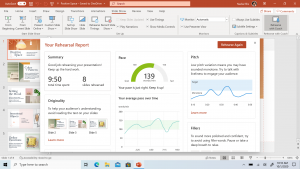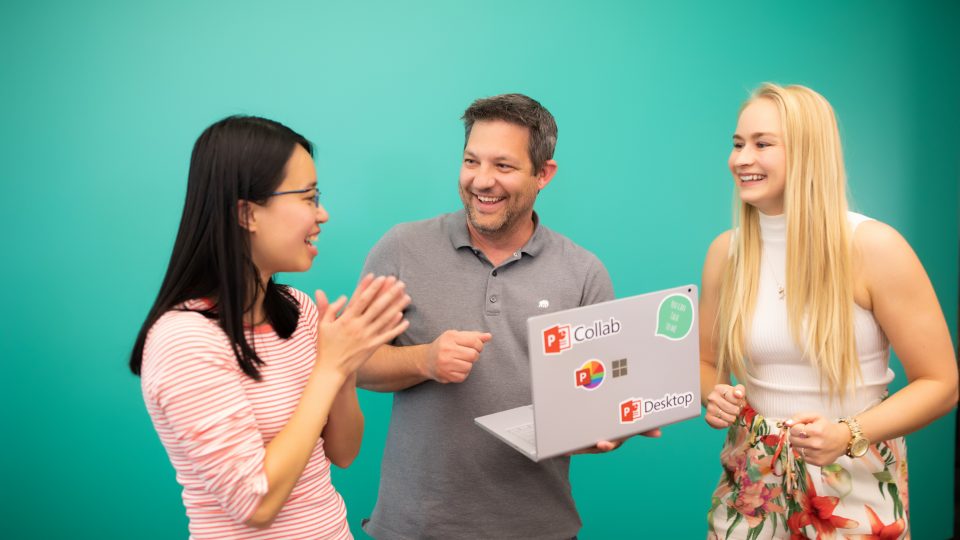Shawn Villaron has been with Microsoft since 1996, currently serving as partner group program manager for PowerPoint — a division he has seen grow exponentially during that time. As he enters his fourth decade growing alongside it, he has some amazing stories about innovation, success, and failure — and how best to learn from all three.
We recently sat down for a chat with him to go over some of these hard-earned lessons. Villaron, who is based in the Bay Area, said it can all be boiled down to one legacy: customer obsession, achieved through a growth mindset and a willingness to take risks.
With that in mind, here are five things you probably didn’t know about PowerPoint — and how they can inspire us all.
1. Listen to the customers — “On the topic of customer obsession, we have some really good stories. We’ve leveraged a lot of conferences, driving value back into the product and the industry,” he recalls. “At one conference about two years ago in San Antonio, we had a team of people from the PowerPoint team, and one of our engineers was told there was a bug in Morph [a popular PowerPoint transition].”
With a laugh, he explains what happened next. “We have a picture of that engineer who — right there — grabbed his mobile phone, remoted into this engineering environment, discovered the bug and fixed it. We were able to turn out a response in hours.”
It’s just one example of such in-the-moment improvements bettering the PowerPoint experience for all. “That shows how willing we are to pull out the stops, no matter how hard it is,” he adds. “Nobody wants to write code on a mobile phone, but that’s how determined that engineer was to solve that customer’s problem.”
2. Explore, then learn — To successfully ride the turning tides of technology, resist the temptation to think you know everything. “We try to approach shifts in the business from the standpoint of: ‘Let’s assume the shift is real, and let’s explore it.’ Of course, we want to talk enough to get conviction that there may be a ‘there there’— but we prefer action over talking,” Villaron explains.
The PowerPoint team has embraced various trends over the years — taking stock of the landscape so as not to be left behind, then putting their own stamp on things when the time is right. “There was a moment, years ago, where we were thinking web apps were really important. We were a rich client company, and we started to think web apps might be a critical investment going forward, so we dove in,” he recalls. “We didn’t wait around for a signal from the industry that this was it. We dove in, said let’s learn, and if we have to pull back, we will.”
It was that mindset that also put PowerPoint on the forefront of the AI revolution. “There was another moment years ago when we were looking at how we could accelerate the delivery of value to customers when the number of endpoints PowerPoint ran on—Windows, Mac, the web, Android, iPad, iPhone — was increasing,” explains Villaron. “That caused us to think about what role services could play, rather than our go-to approach of using client code. So, we were one of the first teams in Office to start pushing services and think about what we had learned from those early web days that could inform our shift to services. And that’s where we ended up building a portfolio of services that are used broadly across Office, around thumbnail generation, PDF generation and file transformations, etc., because we were thinking early about new technology that could add value.”
“That laid the foundation for all our AI work — PowerPoint Designer and Presenter Coach,” he adds. “When we looked at AI, didn’t have everything clear, but we took that intuition telling us that this was the future and ran with it.”
3. Reach higher — When presented with a challenge, the PowerPoint team makes it a point to understand what it can reasonably achieve — and then set their sights a little higher.
“When we were building the web app, one thing we noticed was that PowerPoint’s loading performance wasn’t where we wanted it to be,” Villaron recalls as one example. “It was measured at about 20 seconds for the 95th percentile, which is pretty slow.”
Determined to improve the loading time, they went through a process that offers  great insight into how they think. “We went to the leadership team and said this is something we need to fix, and they said what’s the goal, and our response was that we were reasonably confident we could shave seven seconds off.”
great insight into how they think. “We went to the leadership team and said this is something we need to fix, and they said what’s the goal, and our response was that we were reasonably confident we could shave seven seconds off.”
Conversations then followed about breaking the double-digit mark, and whether they could go even further. “We finally landed on five seconds as the goal or shaving 13 seconds off the current loading time. We took on this five second goal, because it told the team, this is where our focus should be,” he explains. “We didn’t want to look at linear solutions, we wanted to look for non-linear ones. We wanted people to get super creative, try crazy things, not worry about whether they’ll fail, but be willing to question everything.”
Ultimately, they fell a bit short. “We had a review where we had gotten down to seven seconds, and we met with execs. It would have been perfectly reasonable for them all to say: ‘You failed. Seven is greater than five. Get out,’” Villaron remembers of the meeting. “Instead, everybody was celebrating the aggressive goal, the fact that we had made so much progress.”
He adds: “I tell this story to remind people that you shouldn’t settle for what you know you can achieve; stretch yourself, stretch the organization, put it on the line.”
4. The game-changing acquisition —You’re most likely well aware of Microsoft’s 2016 acquisition of LinkedIn, but what you might not know is how dramatically it has impacted PowerPoint — and vice versa.
“We love to leverage the fact that the PowerPoint team is in Silicon Valley,” says Villaron. “For instance, we’re obviously interested in making sure Office365 is a great modern productivity solution for everyone needing to get things done; that was helped tremendously when we acquired LinkedIn, a very modern company — they’re very mobile, very collaborative.”
He adds: “We’ve used them as a proxy for helping not only PowerPoint but all of Office evolve to meet the needs of customers working in modern ways. We’ve established a super-deep partnership with LinkedIn; pre-COVID, we’d go over to their offices and do monthly checkpoints, employee reviews, we’d follow them to conferences and watch how they use our products. We have metrics like NPS (Net Promoter Score) that we use to monitor their happiness with Office365. But what I love the most about the partnership is that our approach has been to earn – and not mandate – their usage. And if you look at the data, it’s clear that we have real Office365 fans at LinkedIn.”
From the beginning, he says the two teams have been perfect for each other. “They’re in the Valley, and it’s a match made in heaven; we were right across the street from them, so we could build those relationships,” he explains. “The transformation of Office over the past few years has been heavily influenced by this partnership.”

5. A cascading influence — It’s no secret that Silicon Valley is home to all sorts of dynamic companies; if you’re trying to choose which is for you, Villaron is quick to point out that PowerPoint has a history of enabling people to be influential across multiple fronts.
“There’s a great story surrounding Presenter Coach. There’s this technology in Redmond that helps us capture voice input, parsing what’s being said and working a bunch of magic,” he explains. “We felt that we could leverage this technology to help people become better presenters, hence the notion of a Presenter Coach. We went from inception to shipping in about nine months, super-fast for something as complicated as this.”
But the tech didn’t only improve PowerPoint. “We got the Flipgrid team in Minneapolis to take our tech and build it into Flipgrid. We also went across the street to LinkedIn and they integrated it into their interviewing tool,” Villaron points out with pride. “I love that, because if someone is sitting there thinking ‘Do I join a team like Office in the Valley?’ They may artificially think their opportunity to contribute is limited to the PowerPoint team; but as Presenter Coach shows, you have the potential to have a broad influence across Microsoft Working in the Valley, people can have a real impact.”
If you’d like to join the PowerPoint team or explore other local roles, career opportunities can be found here: https://aka.ms/MicrosoftBayAreaCareers.




